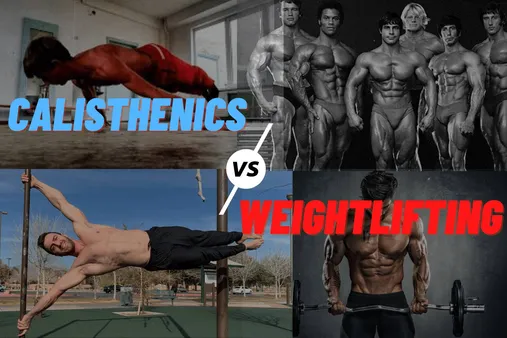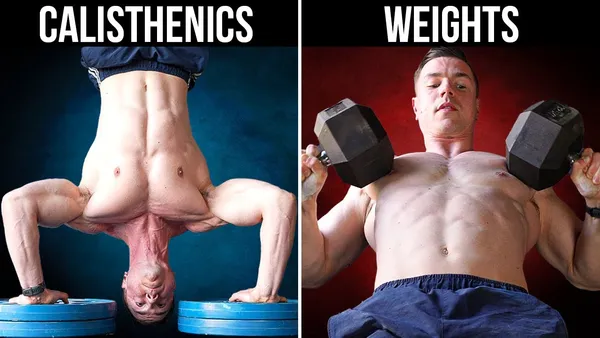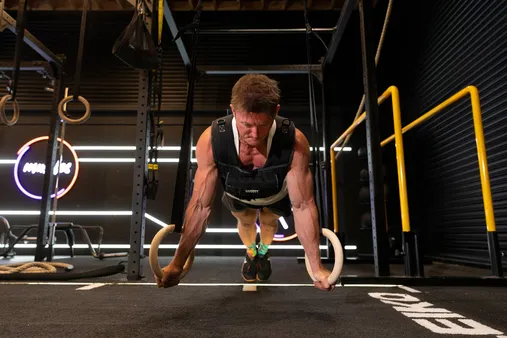Table of Contents
Calisthenics and weightlifting are two popular forms of exercise that can provide a variety of benefits. Both calisthenics and weights can help you build strength, muscle, and endurance, and both can be tailored to your individual fitness level. So, which is better: calisthenics or weights? The answer depends on your individual goals and preferences. In this article, we will compare calisthenics and weights, and help you decide which is the best option for you. We will discuss the benefits of each type of exercise, the equipment you need, and how to get started. We will also provide some tips for maximizing your results. Whether you are a beginner or a seasoned athlete, this article will help you achieve your fitness goals with calisthenics or weights. Read more from Kizworld website about calisthenics or weights from the link below.
Calisthenics or Weights: Which is Right for You?
Type | Pros | Cons |
|---|---|---|
Calisthenics | -Requires no equipment -Can be done anywhere -Builds strength, flexibility, and endurance | -May not be as effective for building muscle mass -Can be difficult for beginners -May not be suitable for people with injuries |
Weights | -More effective for building muscle mass -Can be tailored to your specific goals -Safer than calisthenics | -Requires a gym membership or home gym -Can be more time-consuming -May not be suitable for people with injuries |
I. Calisthenics or Weights: The Pros and Cons
Benefits of Calisthenics
Calisthenics offers a range of benefits, making it a popular choice for those seeking to improve their fitness. Its accessibility, effectiveness, and versatility contribute to its appeal. Here are some of the key advantages of calisthenics:- **No equipment required:** One of the significant advantages of calisthenics is that it eliminates the need for expensive equipment or gym memberships. This makes it an accessible form of exercise for individuals of all ages, backgrounds, and income levels.- **Convenience and flexibility:** Calisthenics can be performed anywhere, anytime, providing flexibility and convenience tailored to your schedule and preferences. Whether you prefer to train at home, in a park, or while traveling, calisthenics offers the freedom to fit exercise into your daily routine without constraints.- **Versatile and adaptable:** Calisthenics exercises are not limited to specific body parts or muscle groups. They can be modified and adapted to suit various fitness levels, making them suitable for beginners, advanced athletes, and everyone in between.- **Improves functional fitness:** Calisthenics emphasizes compound movements that engage multiple muscle groups simultaneously. By mimicking everyday activities such as pushing, pulling, and squatting, it enhances functional fitness and translates into improved mobility, balance, and daily life activities.- **Cost-effective:** Calisthenics is generally more cost-effective compared to gym memberships or personal training sessions. It eliminates the need for monthly fees, expensive equipment, or specialized facilities, saving you money while achieving your fitness goals.Discover the Importance of Mobility and Flexibility in Calisthenics>>
Type | Pros | Cons |
|---|---|---|
Calisthenics | -Requires no equipment-Can be done anywhere-Builds strength, flexibility, and endurance | -May not be as effective for building muscle mass-Can be difficult for beginners-May not be suitable for people with injuries |
Weights | -More effective for building muscle mass-Can be tailored to your specific goals-Safer than calisthenics | -Requires a gym membership or home gym-Can be more time-consuming-May not be suitable for people with injuries |
Benefits of Weights
Weightlifting, also known as resistance training, involves using external weights to build muscle mass, strength, and power. It offers several advantages that complement calisthenics or serve as an alternative path to fitness. Here are some of the main benefits of weightlifting:- **Increased muscle mass and strength:** Weightlifting is particularly effective for building muscle mass and increasing strength. By progressively overloading muscles, it stimulates muscle growth, leading to enhanced physical performance and aesthetics.- **Improved bone density:** Weight-bearing exercises such as weightlifting promote bone growth and density, reducing the risk of osteoporosis and fractures. This is especially important for individuals at risk of bone loss, such as postmenopausal women and seniors.- **Enhanced metabolism:** Weightlifting helps boost metabolism, both during and after workouts. By increasing muscle mass, it elevates the body's resting metabolic rate, resulting in increased calorie burn throughout the day.- **Reduced risk of chronic diseases:** Regular weightlifting has been associated with a reduced risk of chronic diseases, including cardiovascular disease, type 2 diabetes, and some types of cancer. It improves cardiovascular health by lowering blood pressure and cholesterol levels.- **Improved joint stability:** Contrary to popular belief, weightlifting, when performed with proper form, can strengthen the muscles and tissues surrounding joints, providing stability and reducing the risk of injuries.Unlock the Ultimate Calisthenics Workout with Our Videos>>- **Improved mood and cognitive function:** Weightlifting has been shown to have positive effects on mood and cognitive function. It releases endorphins, which have mood-boosting effects, and promotes the production of neurotrophic factors, supporting brain health and reducing the risk of cognitive decline.- **Increased flexibility and range of motion:** When incorporated into a balanced fitness routine, weightlifting can contribute to improved flexibility and range of motion. By strengthening muscles and improving mobility, it enhances overall physical function and quality of life.- **Injury prevention:** Weightlifting can help prevent injuries by strengthening muscles and connective tissues. Strong muscles and joints provide stability and support to the body, reducing the risk of sprains, strains, and other injuries during everyday activities or athletic pursuits.
Calisthenics or Weights: The Pros and Cons
II. Benefits of Calisthenics
Improved Body Composition
Calisthenics is a great way to improve your body composition. It can help you lose weight, gain muscle, and reduce body fat. Calisthenics exercises are bodyweight exercises, so they do not require any special equipment. This makes them a great option for people who are new to exercise or who do not have access to a gym.How to Build Muscle and Strength With Calisthenics
Increased Strength and Flexibility
Calisthenics exercises can help you increase your strength and flexibility. Calisthenics exercises work multiple muscle groups at once, so they are a great way to build functional strength. Calisthenics exercises also help to improve your flexibility, which can reduce your risk of injury and improve your overall mobility.And Flexibility With Calisthenics
Improved Cardiovascular Health
Calisthenics exercises can help you improve your cardiovascular health. Calisthenics exercises are typically performed at a high intensity, which means they can help to improve your heart rate and blood flow. Calisthenics exercises can also help to lower your blood pressure and cholesterol levels.
Type | Pros | Cons |
|---|---|---|
Calisthenics | -Requires no equipment-Can be done anywhere-Builds strength, flexibility, and endurance | -May not be as effective for building muscle mass-Can be difficult for beginners-May not be suitable for people with injuries |
Weights | -More effective for building muscle mass-Can be tailored to your specific goals-Safer than calisthenics | -Requires a gym membership or home gym-Can be more time-consuming-May not be suitable for people with injuries |
Benefits of Calisthenics
III. Benefits of Weights
More Effective for Building Muscle Mass
Weights are more effective for building muscle mass than calisthenics because they allow you to lift heavier weights. This is important for stimulating muscle growth. When you lift weights, you create tiny tears in your muscle fibers. These tears are then repaired and rebuilt, which makes your muscles stronger and larger.
Calisthenics exercises can also help you build muscle, but they are not as effective as weights. This is because calisthenics exercises typically involve using your own body weight as resistance. This means that you are limited in how much weight you can lift.
If you are serious about building muscle mass, then weights are the better option. However, if you are just starting out, then calisthenics can be a good way to get started.
Can Be Tailored to Your Specific Goals
Another benefit of weights is that they can be tailored to your specific goals. For example, if you want to build strength, you can lift heavy weights for a few repetitions. If you want to build endurance, you can lift lighter weights for more repetitions.
Calisthenics exercises can also be tailored to your specific goals, but they are not as versatile as weights. This is because calisthenics exercises are limited by your own body weight.
If you have specific fitness goals, then weights are the better option. However, if you are just starting out, then calisthenics can be a good way to get started.
Safer Than Calisthenics
Finally, weights are generally safer than calisthenics. This is because calisthenics exercises can put a lot of stress on your joints. This can lead to injuries, especially if you are not properly trained.
Weights, on the other hand, are less likely to cause injuries. This is because weights allow you to control the amount of weight you are lifting. You can also use proper form to reduce the risk of injury.
If you are concerned about safety, then weights are the better option. However, if you are properly trained, then calisthenics can be a safe and effective way to get in shape.
Type | Pros | Cons |
|---|---|---|
Calisthenics | -Requires no equipment-Can be done anywhere-Builds strength, flexibility, and endurance | -May not be as effective for building muscle mass-Can be difficult for beginners-May not be suitable for people with injuries |
Weights | -More effective for building muscle mass-Can be tailored to your specific goals-Safer than calisthenics | -Requires a gym membership or home gym-Can be more time-consuming-May not be suitable for people with injuries |
Ultimately, the best way to decide which type of exercise is right for you is to try both and see what you prefer. Both calisthenics and weights have their own benefits and drawbacks, so it really depends on your individual needs and preferences.
If you are new to exercise, it is important to start slowly and gradually increase the intensity of your workouts over time. This will help you to avoid injuries and get the most out of your workouts.
No matter which type of exercise you choose, it is important to be consistent with your workouts. The more you exercise, the better results you will see.
Here are some related posts that you may find helpful:
- How to Do a Muscle Up
- The Best Calisthenics Gifts and Accessories
- The Best Calisthenics Quotes and Motivation
Benefits of Weights
IV. Calisthenics vs. Weights: Which is Right for You?
Ultimately, the best way to decide which type of training is right for you is to try both and see what you enjoy more. If you're new to exercise, starting with calisthenics may be a good option, as it's a great way to build a foundation of strength and flexibility. Once you've mastered the basics of calisthenics, you can then add weights to your routine to further challenge yourself.
No matter which type of training you choose, the most important thing is to be consistent with your workouts. If you stick with it, you'll see results in no time.
Factor | Calisthenics | Weights |
|---|---|---|
Equipment | No equipment required | Requires weights or gym membership |
Cost | Free | Can be expensive |
Convenience | Can be done anywhere | Requires access to a gym or home gym |
Effectiveness | Effective for building strength, flexibility, and endurance | More effective for building muscle mass |
Safety | Can be more difficult for beginners | Safer than calisthenics |
Here are some additional factors to consider when choosing between calisthenics and weights:
- Your fitness goals
- Your fitness level
- Your budget
- Your schedule
- Your personal preferences
If you're still not sure which type of training is right for you, talk to a personal trainer. They can help you assess your fitness level and goals and recommend the best type of training for you.
No matter which type of training you choose, the most important thing is to have fun and stick with it. If you enjoy your workouts, you're more likely to see results and reach your fitness goals.
Here are some related posts that you may find helpful:
- How to Do a Muscle-Up
- The Best Calisthenics Gifts and Accessories
- The Best Calisthenics Quotes and Motivation
Calisthenics vs. Weights: Which is Right for You?
V. Conclusion
Ultimately, the choice between calisthenics and weights depends on your individual goals, fitness level, and preferences. Both forms of exercise offer unique benefits and can help you achieve your fitness goals. 💪 If you're new to exercise or have any injuries or limitations, calisthenics may be a good starting point. It's a low-impact form of exercise that can help you build strength, flexibility, and endurance without putting too much strain on your body. If you're looking to build muscle mass or strength train for specific sports, weights may be a better choice. Weightlifting can help you build muscle mass, strength, and power, and it can also improve your bone density. The best way to decide which form of exercise is right for you is to try both and see what you enjoy more. You can also consult with a fitness professional to get personalized advice. 🤝